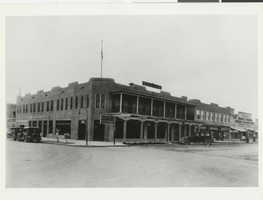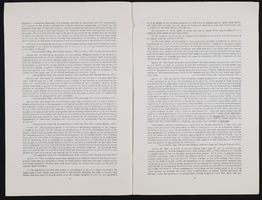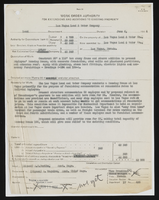Search the Special Collections and Archives Portal
Search Results
John W. Crabbe oral history interview
Identifier
Abstract
Oral history interview with John W. Crabbe conducted by Patricia van Betten on January 19, 2004 for the Blue Diamond Oral History Project. In the interview, Crabbe discusses moving to Blue Diamond Village in southern Nevada as a child in the 1950s. Crabbe talks about attending Rancho High School in Las Vegas, Nevada and the long bus commute he took daily to school. Crabbe then recalls his experiences horseback riding in Bonnie Springs, Nevada and his employment at Howard Hughes' airline, Hughes Air West. Lastly, Crabbe discusses the civic activities available growing up in the Blue Diamond Village.
Archival Collection
Susan and Holly Carratelli oral history interviews
Identifier
Abstract
Oral history interviews with Susan and Holly Carratelli conducted by Dennis McBride on June 24 and 26, 1999 for the Las Vegas Gay Archives Oral History Project. In the interviews, Susan and Holly recall first meeting during the planning for the 1994 National Coming Out Day event in Las Vegas, Nevada. They discuss what they value in a relationship, their past relationship experiences, and their involvement with the Gay and Lesbian Community Center and Metropolitan Community Church. Other subjects they cover include their marriage, anecdotes about living together, having children, their daily routine, and conflicting inter-community perceptions between gay men and women in Las Vegas.
Archival Collection
An Interview with Judith Lee Johnson Jones
Identifier
Abstract
Oral history interview with Judith Lee Johnson Jones conducted by Claytee D. White on February 22, 2007 for the Boyer Early Las Vegas Oral History Project. Johnson Jones discusses winning a contest that allowed her to be a showgirl at the Sands Hotel and Casino when she was seventeen, receiving a college degree in Houston, Texas, and performing in the Elvis movie “Viva Las Vegas.” She also talks about her twenty-nine-year career in education.
Archival Collection
Ethel S. Hatch oral history interview
Identifier
Abstract
Oral history interview with Ethel S. Hatch conducted by P. Kohlman on November 24, 1975 for the Ralph Roske Oral History Project on Early Las Vegas. This interview covers the history of Las Vegas from 1939 to 1975. Mrs. Hatch also talks about ranching in Nevada, Rex Bell, development on the Strip, the first hotels, and early local shopping culture. The interview concludes with discussion surrounding tree-lined streets, the Helldorado Club, and Fremont Street.
Archival Collection
Jacqueline MacFarlane oral history interview
Identifier
Abstract
Oral history interview with Jacqueline MacFarlane conducted by Claytee D. White on February 04, 2010 for the Boyer Early Las Vegas Oral History Project. In this interview Jacqueline MacFarlane discusses her early childhood in Las Vegas, Nevada, her move to rural Nevada because of the Great Depression, her move back to Las Vegas, and meeting her husband David MacFarlane, an Air Force Cadet, at the Nellis Air force Base. She then discusses family life, Las Vegas in the 1950s and 1960s, and the various jobs she held on the Las Vegas Strip.
Archival Collection
Series I. The Caddo Company, Incorporated, 1922 to 1965
Level of Description
Scope and Contents
The Caddo Company, Incorporated series (1922-1965) is comprised of twelve sub-series containing film production and corporate records.
The first two sub-series contain materials related to two films that predate the formation of The Caddo Company, Incorporated as a production company,
Materials within each film sub-series include advertising and publicity, administrative, censorship, distribution, editing, financial, legal, and production and direction records, as well as film soundtracks and screenplays. Types of materials include of ledgers, correspondence, storyboard images, sheet music, and original scores, as well as film, direction, set, and production stills. Corporate records consist of newspaper clippings, administrative correspondence, actor and distribution contracts, and financial reports.
Archival Collection
Collection Name: Howard Hughes Film Production Records
Box/Folder: N/A
Archival Component


Photograph of the front exterior of the Hotel Nevada (Las Vegas), circa 1910
Date
Archival Collection
Description
Hotel Nevada after the addition of a balcony. Transcribed from photo sleeve: "by Florence Lee Jones ... March, 1969. Early Las Vegas History. The Hotel Nevada, at the Southeast corner of Main and Fremont Streets, is the oldest continuous hotel business in Las Vegas, although it has been known as Sal Sagev (Las Vegas spelled backward) since 1928. The hostelry started as a tent in 1905, but the late John Miller soon erected a permanent building, shown above, which provided the most luxurious accommodations and the best food in Las Vegas for many years. In the 1930's the Sal Sagev Hotel had one of the three elevators in town. A private dining room was a popular place for private parties for the elite of the town. The hotel is now owned and operated by Miller's son, Abe Miller, and his daughter, Mrs. Sherman E. Nugent. The Golden Gate Club now occupies much of the first floor of the building. On the North side of the building is a sign "Bank of Southern Nevada", which was the second bank established in Las Vegas. (The other was the First State Bank.) Started by John F. Miller, Ed Von Tobel, Sr., Will Beckley, Attorney Frank Stevens, and Hal D. Buzick, the Bank of Southern Nevada was an important factor in Southern Nevada's economy. During the 1930's and the Depression, the federal government issued restrictive orders on bank operations. The reaction of the independent Las Vegans was 'No guy in Washington is going to tell us how to run our bank.' ... So they paid off all the depositors and closed the bank. The Rhoads & Rhoads General Machine Works (extreme right) was one of the first automobile agencies in town - the start of Community Chevrolet."
Site Name: Hotel Nevada
Address: 1 Fremont Street
Image


